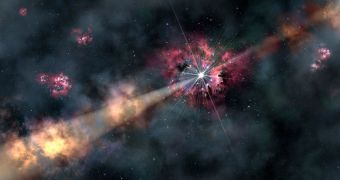Scientists using NASA's Swift space telescope and several land-based telescopes were able to observe the effects of a rare phenomenon, namely a gamma ray burst (GRB), made even rarer by its unusual length and, most importantly, its age.
In the early days of our universe, some 12.7 billion years ago, one of the first stars to ever exist was having its final moments.
"This star lived at a very interesting time, the so-called dark ages just a billion years after the Big Bang," Ryan Chornock of the Harvard-Smithsonian Center for Astrophysics said.
"In a sense, we're forensic scientists investigating the death of a star and the life of a galaxy in the earliest phases of cosmic time," he added.
As the star collapsed, it emitted an intense burst of highly-energetic radiation, a GRB. This particular burst lasted for four minutes, much longer than the average one.
As the energetic light from the star traveled through its galaxy, it heated up the material it encountered. 12.7 billion years later, that light reached Earth and was detected by the Swift telescope.
Astronomers then scrambled to point other telescopes to the precise location of the energy source to study its aftermath.
As the light traveled through the early galaxy, it encountered gases and other material and interacted with them, creating a unique signature. Astronomers were able to study how the material around the star reacted to find out what chemical elements were present in the early days of the universe.
As expected, only one tenth of the metals found in our solar system today were present back then. None of the heavier elements that make life possible, like carbon or oxygen, had been created, since the stars that could make them didn't exist yet.
"At the time this star died, the universe was still getting ready for life. It didn't have life yet, but was building the required elements," Chornock explained.

 14 DAY TRIAL //
14 DAY TRIAL //